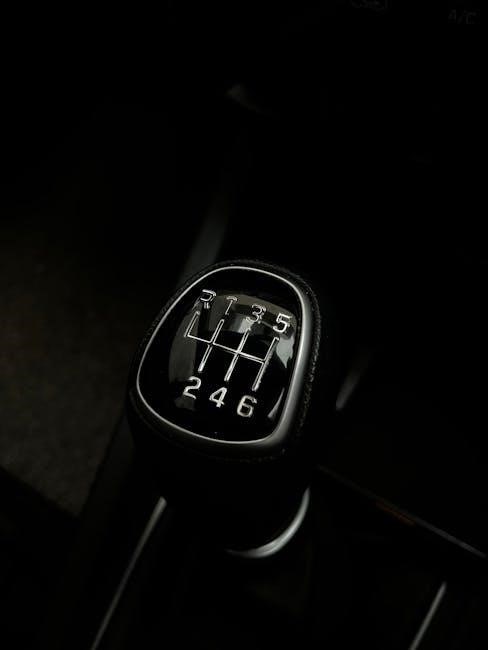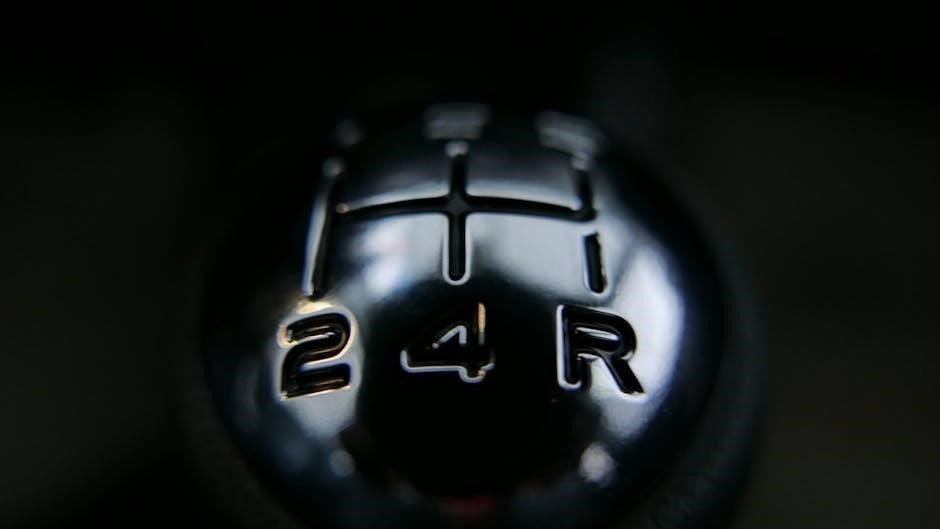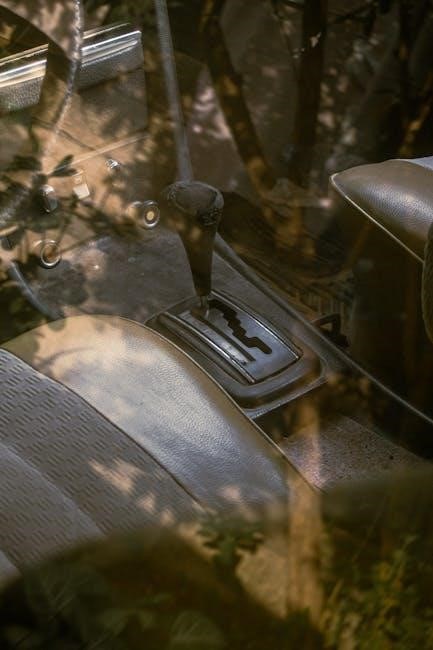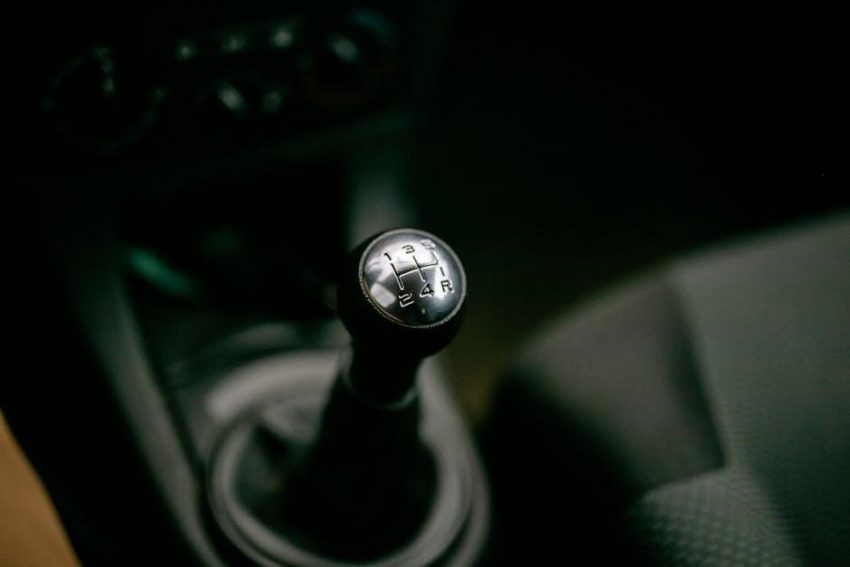Converting a manual gearbox to an automatic transmission is a complex process gaining popularity for convenience and ease of driving, despite requiring significant drivetrain modifications and investment.
1.1 Overview of the Process
Converting a manual gearbox to an automatic involves replacing the manual transmission with an automatic unit, adapting the drivetrain, and integrating necessary components like the ECU and shifter mechanism. The process requires expertise, specialized tools, and significant modifications, making it a challenging and costly endeavor that varies by vehicle make and model.
1.2 Importance of Understanding the Differences Between Manual and Automatic Transmissions
Understanding the differences between manual and automatic transmissions is crucial for a successful conversion. Manual transmissions rely on driver input for gear shifts, while automatics use a torque converter and complex hydraulic systems. Recognizing these distinctions ensures compatibility and proper integration during the conversion, avoiding potential mechanical issues and ensuring optimal performance.
Key Considerations Before Converting
Converting to automatic involves significant costs, complex modifications, and compatibility checks. Assessing feasibility, budgeting for parts and labor, and evaluating necessary drivetrain changes are essential steps.
2.1 Feasibility and Cost Implications
Evaluating the feasibility of converting a manual to automatic transmission requires considering high costs, including parts like the pedal box, gearbox, and ECU. Labor expenses are substantial, and finding a qualified mechanic can be challenging. Additionally, some functions may not work as intended, and unauthorized modifications can void warranties, adding to the financial risks.
2.2 Vehicle Compatibility and Required Modifications
Converting a manual to automatic transmission demands vehicle compatibility checks. Significant modifications are needed, including replacing the pedal box, shifter mechanism, and integrating new ECU systems. The drivetrain must be overhauled to support the automatic gearbox, with variations depending on the vehicle’s make, model, and year, ensuring a seamless integration of all components for proper functionality.
2.3 Expertise and Tools Needed for the Conversion
Converting a manual to automatic transmission requires specialized expertise and tools. A skilled mechanic with experience in drivetrain modifications is essential. Specific tools like transmission jacks, diagnostic equipment, and custom fabrication tools may be necessary. Without proper knowledge and equipment, the conversion could result in faulty installation, leading to poor performance or safety hazards.
Steps Involved in the Conversion Process
Converting a manual to automatic involves removing the manual transmission, installing the automatic unit, and adapting drivetrain components to ensure compatibility and proper system integration.
3.1 Removing the Manual Transmission
Removing the manual transmission involves disconnecting the gearbox from the engine, drivetrain, and pedals. This step requires detaching electrical connectors, hydraulic lines, and mechanical linkages. Specialized tools are needed to safely extract the unit without damaging surrounding components. Proper care ensures the vehicle remains stable during the process, preparing it for the automatic transmission installation.
3.2 Installing the Automatic Transmission
Installing the automatic transmission requires precise alignment and mounting of the new unit. Key steps include connecting the torque converter to the engine, linking the transmission to the drivetrain, and integrating electronic controls. The process demands careful adjustment of the ECU and pedal systems to ensure compatibility and smooth operation. Professional expertise is crucial to avoid mechanical or electrical issues during this phase.
3.3 Adapting the Drivetrain and Supporting Systems
Adapting the drivetrain involves modifying components to integrate seamlessly with the automatic transmission. This includes upgrading the ECU to recognize the new system, adjusting the pedal box for automatic compatibility, and ensuring proper alignment of the driveshaft. Additionally, cooling systems may need enhancement, and the vehicle’s wiring must be updated to support advanced transmission features, ensuring optimal performance and reliability post-conversion.

Cost Implications and Financial Considerations
Converting a manual to an automatic transmission involves substantial costs, including parts like the gearbox, ECU, and labor fees. Additional expenses may arise from unforeseen modifications.
4.1 Estimated Costs for Parts and Labor
Estimated costs for converting a manual to automatic transmission range from $2,000 to $10,000+, depending on the vehicle and complexity. Parts include a new automatic gearbox, ECU, pedal box, and shifter mechanism. Labor costs are significant, as specialized expertise is required. DIY kits may reduce expenses but are challenging without professional experience, making labor a major financial consideration.
4.2 Hidden Expenses and Potential Risks
Hidden expenses include unexpected repairs, wiring issues, and ECU compatibility problems. Potential risks involve voiding the vehicle’s warranty, improper installation leading to system failure, and challenges in sourcing compatible parts. Additionally, labor costs may escalate if unforeseen complications arise, making professional consultation crucial to mitigate these risks and ensure a smooth conversion process.
4.3 Budgeting for Unexpected Repairs or Adjustments
Budgeting for unexpected repairs or adjustments is crucial, as hidden costs often arise during a manual to automatic gearbox conversion. These may include additional labor fees, unforeseen part replacements, or system integration issues. Experts recommend allocating 10-15% of the total budget for contingency expenses to address potential setbacks and ensure the conversion process remains financially manageable and stress-free.

Benefits of Converting to an Automatic Transmission
Converting to an automatic transmission offers enhanced driving convenience, reduced driver fatigue, and smoother city driving, making it ideal for urban environments and less experienced drivers.
5.1 Improved Driving Convenience
Converting to an automatic transmission significantly enhances driving convenience, especially in stop-and-go traffic, where manual shifting becomes tedious. Automatic transmissions eliminate the need for constant gear changes, reducing driver fatigue and stress. This makes urban driving smoother and more enjoyable, particularly for inexperienced drivers. Additionally, parking and low-speed maneuvers become easier, as the vehicle automatically adjusts without manual intervention.
5.2 Potential Performance Enhancements
Automatic transmissions can offer smoother acceleration and faster gear shifts compared to manual options, particularly in modern systems like dual-clutch transmissions. This seamless power delivery enhances performance, especially in high-torque applications. Additionally, automatics often optimize engine RPMs during acceleration, providing better responsiveness and traction control, which can be advantageous in various driving conditions and improve overall vehicle performance.
5.3 Reduced Wear and Tear on Clutch and Gearbox
Switching to an automatic transmission eliminates the need for manual clutch operation, significantly reducing wear on the clutch assembly and gearbox components. This minimizes the frequency of clutch replacements and gearbox repairs, leading to lower maintenance costs over time. Automatic transmissions also distribute mechanical stress more evenly, further extending the lifespan of drivetrain components and ensuring smoother, longer-lasting performance.
Common Concerns and Potential Drawbacks
Common concerns include higher fuel consumption, loss of driver engagement, and increased maintenance costs. Automatic transmissions can be heavier and more expensive to repair, while conversion costs are significant. Additionally, unauthorized modifications may void warranties, posing financial risks.
6.1 Impact on Fuel Efficiency
Converting to an automatic transmission often results in reduced fuel efficiency compared to manual gearboxes. Automatics, especially older models, typically consume more fuel due to the torque converter’s energy loss and lack of direct control over gear shifts. However, modern automatic transmissions with advanced technology, such as dual-clutch systems, have narrowed this gap, offering improved efficiency closer to manual transmissions.
6.2 Loss of Driver Control and Engagement
Converting to an automatic transmission often results in a loss of driver control and engagement. Manual transmissions allow drivers to actively participate in gear shifting, creating a more connected driving experience. Automatics, while convenient, reduce the need for driver input, which can lead to a less immersive and less engaging driving experience for enthusiasts who enjoy the hands-on control of a manual gearbox.
6.3 Maintenance and Repair Challenges
Automatic transmissions are more complex than manuals, leading to higher maintenance and repair costs. Specialized tools and expertise are often required, making it difficult to find qualified mechanics. Additionally, converting from manual to automatic may introduce unique challenges, such as compatibility issues and unexpected repair needs, increasing the likelihood of costly and time-consuming fixes over time.

DIY vs. Professional Conversion
Converting a manual to automatic transmission can be cost-effective as a DIY project but requires specialized tools and expertise, making professional conversion often more reliable despite higher costs.
7.1 Pros and Cons of a DIY Approach
A DIY manual to automatic conversion can be cost-effective, allowing enthusiasts to save on labor costs and gain hands-on experience. However, it requires extensive mechanical knowledge, specialized tools, and time. Errors can lead to system malfunctions or safety hazards. Success heavily depends on the individual’s expertise and access to proper resources and guidance. Professional assistance is often recommended for reliability and safety.
7.2 Finding a Qualified Mechanic or Garage
Locating a qualified mechanic or garage experienced in manual to automatic conversions is crucial for a successful outcome. Research local shops, check reviews, and ask for references to ensure reliability. A reputable garage with expertise in transmission work will have the necessary tools and knowledge to handle the complexity of the conversion, ensuring precise execution and reliable results.
7.3 Risks of Unauthorized Modifications
Unauthorized modifications for manual to automatic conversions pose significant risks, including voiding the car’s warranty and potential safety hazards. Improper installations can lead to system malfunctions, reduced performance, and even accidents. Additionally, unauthorized work may result in legal consequences and higher long-term costs due to improper integration with the vehicle’s existing systems, emphasizing the importance of using certified professionals.

Case Studies and Real-World Examples
Case studies reveal successful manual-to-automatic conversions, such as the 1965 Chevy transmission swap and Toyota LandCruiser LC100 projects, highlighting challenges, successes, and insights from real-world applications.
8.1 Successful Manual to Automatic Conversions
Notable successes include the 1965 Chevrolet Nova and Toyota LandCruiser LC100, where enthusiasts achieved seamless manual-to-automatic swaps, enhancing drivability without compromising performance. These projects highlight meticulous planning, expert execution, and the importance of component compatibility, serving as inspiration for others considering similar conversions.
8.2 Lessons Learned from Previous Projects
Previous manual-to-automatic conversion projects reveal that while achievable, the process demands careful planning, substantial financial investment, and professional expertise. Compatibility issues, unexpected costs, and post-conversion adjustments are common challenges. Successful outcomes often rely on precise component selection and skilled labor, emphasizing the importance of thorough research and consultation with specialists before embarking on such a complex undertaking.
8.3 Industry Trends and Innovations
The automotive industry is witnessing advancements in transmission technology, with automated manual transmissions (AMT) and dual-clutch transmissions (DCT) emerging as bridges between manual and automatic systems. Innovations like KTM’s AMT in the 1390 Super Adventure tourer and high-performance DCT implementations in modified vehicles, such as the 1200-hp Dodge Viper by Carma Performance, highlight the trend toward blending efficiency and driver engagement, pushing the boundaries of gearbox conversion possibilities.
Converting a manual to an automatic transmission is a complex, costly process, but offers improved convenience and ease of driving, making it a viable option for many drivers.
9.1 Is the Conversion Worth the Effort?
Converting a manual to an automatic transmission can be worthwhile for drivers seeking convenience and ease, especially in heavy traffic. However, the high costs and potential loss of driving engagement may deter enthusiasts. Ultimately, the decision depends on personal preferences, budget, and driving habits, making it essential to weigh the benefits against the drawbacks carefully.
9.2 Future of Transmission Technology
The future of transmission technology is evolving rapidly, with advancements in automatic systems like dual-clutch transmissions and continuously variable transmissions offering improved efficiency. Additionally, hybrid and electric vehicles are reshaping the landscape, potentially reducing the need for traditional manual or automatic gearboxes, and innovations like automated manual transmissions are bridging the gap between manual control and automatic convenience.
9.3 Encouragement for Drivers Considering the Conversion
If you’re contemplating a manual to automatic conversion, weigh the benefits of enhanced convenience and reduced wear on clutch components carefully. While the process is complex and costly, the long-term advantages for ease of driving, especially in urban environments, make it a worthwhile investment for many. Seek professional guidance to ensure a smooth transition and optimal results.

